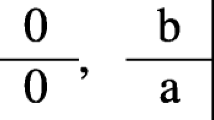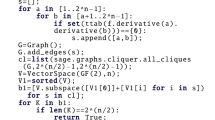Abstract
Some recent research articles (Zhang et al. in Lecture Notes in Computer Science, 10194, 298-313. (2017), Zhang et al. in Discret. Appl. Math. 285(1), 458-472. (2020)) addressed an explicit specification of indicators that specify bent functions in the so-called \({\mathcal C}\) and \({\mathcal D}\) classes, derived from the Maiorana-McFarland (\({\mathcal M}\)) class by C. Carlet in 1994 (Carlet in In Lecture Notes in Computer Science 765, 77–101. (1993)). Many of these bent functions that belong to \({\mathcal C}\) or \({\mathcal D}\) are provably outside the completed \({\mathcal M}\) class. Nevertheless, these modifications are performed on affine subspaces, whereas modifying bent functions on suitable subsets may provide us with further classes of bent functions. In this article, we exactly specify new families of bent functions obtained by adding together indicators typical for the \({\mathcal C}\) and \({\mathcal D}\) class, thus essentially modifying bent functions in \({\mathcal M}\) on suitable subsets instead of subspaces. It is shown that the modification of certain bent functions in \({\mathcal M}\) gives rise to new bent functions which are provably outside the completed \({\mathcal M}\) class. Moreover, we consider the so-called 4-bent concatenation (using four different bent functions on the same variable space) of the (non)modified bent functions in \({\mathcal M}\) and show that we can generate new bent functions in this way which do not belong to the completed \({\mathcal M}\) class either. This result is obtained by specifying explicitly the duals of four constituent bent functions used in the concatenation. The question whether these bent functions are also excluded from the completed versions of \(\mathcal {PS}\), \({\mathcal C}\) or \({\mathcal D}\) remains open and is considered difficult due to the lack of membership indicators for these classes.
Similar content being viewed by others
References
Zhang, F., Cepak, N., Pasalic, E., Wei, Y.: Bent functions in C and D stemming from Maiorana-McFarland class. In Codes, Cryptology and Information Security. C2SI 2017. Lecture Notes in Computer Science, 10194, 298–313. (2017)
Zhang, F., Cepak, N., Pasalic, E., Wei, Y.: Further analysis of bent functions from C and D which are provably outside or inside M#. Discret. Appl. Math. 285(1), 458–472 (2020)
Carlet, C.: Two new classes of bent functions. In Lecture Notes in Computer Science 765, 77–101 (1993)
Rothaus, O.: On bent functions. J. Comb. Theory, Ser. A, 20(3), 300-305. (1976)
Carlet, C.: Boolean Functions for Cryptography and Coding Theory. Cambridge University Press (2021)
Mesnager, S.: Bent functions - Fundamentals and Results. Springer. (2016)
Tokareva, N.: Bent Functions: Results and Applications to Cryptography. Academic Press (2015)
Carlet, C., Mesnager, S.: Four decades of research on bent functions. Des. Codes Cryptogr. 78(1), 5–50 (2016)
Dillon, J.: Elementary Hadamard Difference Sets. PhD thesis, University of Maryland. (1974)
McFarland, R.L.: A family of difference sets in non-cyclic groups. J. Comb. Theory, Ser. A, 15(1): 1–10. (1973)
Dobbertin, H.: Construction of bent functions and balanced Boolean functions with high nonlinearity. In B. Preneel, editor, Fast Software Encryption, pages 61–74, Berlin, Heidelberg. Springer Berlin Heidelberg. (1995)
Langevin, P., Leander, G.: Counting all bent functions in dimension eight 99270589265934370305785861242880. Des. Codes Cryptogr. 59(1), 193–205 (2011)
Kudin, S., Pasalic, E., Cepak, N., Zhang, F.: Permutations without linear structures inducing bent functions outside the completed Maiorana-McFarland class. Cryptogr. Commun. (2021)
Pasalic, E., Zhang, F., Kudin, S., Wei, Y.: Vectorial bent functions weakly/strongly outside the completed Maiorana-McFarland class. Discret. Appl. Math. 294(8), 138–151 (2021)
Bapić, A., Pasalic, E.: Constructions of (vectorial) bent functions outside the completed Maiorana-McFarland class. Submitted to Discret. Appl. Math. (2021)
Canteaut, A., Charpin, P.: Decomposing bent functions. IEEE Trans. Inf. Theory 49(8), 2004–2019 (2003)
Hodžić, S., Pasalic, E., Zhang, W.: Generic constructions of five-valued spectra Boolean functions. IEEE Trans. Inf. Theory 65(11), 7554–7565 (2019)
Carlet, C., Charpin, P., Zinoviev, V.: Codes, bent functions and permutations suitable for DES-like cryptosystems. Des. Codes Cryptogr. 15(2), 125–156 (1998)
Budaghyan, L., Carlet, C., Pott, A.: New classes of almost bent and almost perfect nonlinear polynomials. IEEE Trans. Inf. Theory 52(3), 1141–1152 (2006)
Canteaut, A., Daum, M., Dobbertin, H., Leander, G.: Finding nonnormal bent functions. Discret. Appl. Math. 154(2), 202–218 (2006)
Tang, C., Zhou, Z., Qi, Y., Zhang, X., Fan, C., Helleseth, T.: Generic construction of bent functions and bent idempotents with any possible algebraic degrees. IEEE Trans. Inf. Theory 63(10), 6149–6157 (2017)
Mandal, B., Stǎnicǎ, P., Gangopadhyay, S., Pasalic, E.: An analysis of the C class of bent functions. Fundam. Inform. 146(3), 271–292 (2016)
Zheng, L., Kan, H., Peng, J., Tang, D.: Constructing vectorial bent functions via second-order derivatives. Discrete Math. 344(8), 112473 (2021)
Mesnager, S.: Several new infinite families of bent functions and their duals. IEEE Trans. Inf. Theory 60(7), 4397–4407 (2014)
Hodžić, S., Pasalic, E., Wei, Y.: A general framework for secondary constructions of bent and plateaued functions. Des. Codes Cryptogr. 88(1), 2007–2035 (2020)
Acknowledgements
Amar Bapić is supported in part by the Slovenian Research Agency (research program P1-0404 and Young Researchers Grant). Enes Pasalic is supported in part by the Slovenian Research Agency (research program P1-0404 and research projects J1-9108, J1-1694, N1-0159, J1-2451). Fengrong Zhang is supported in part by the Natural Science Foundation of China (No. 61972400). Samir Hodžić is supported by the Slovenian Research Agency (research program P1-0404 and research projects J1-1694 and N1-1059).
Author information
Authors and Affiliations
Corresponding author
Additional information
Publisher’s Note
Springer Nature remains neutral with regard to jurisdictional claims in published maps and institutional affiliations.
Rights and permissions
About this article
Cite this article
Bapić, A., Pasalic, E., Zhang, F. et al. Constructing new superclasses of bent functions from known ones. Cryptogr. Commun. 14, 1229–1256 (2022). https://doi.org/10.1007/s12095-022-00566-7
Received:
Accepted:
Published:
Issue Date:
DOI: https://doi.org/10.1007/s12095-022-00566-7
Keywords
- \(\mathcal {C}\) class
- \(\mathcal {D}\) class
- Completed Maiorana-McFarland class \(\mathcal {M}^{\#}\)
- \(\mathcal {CD}\) class
- Weakly normal bent functions
- Bent duals
- 4-bent decomposition




